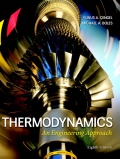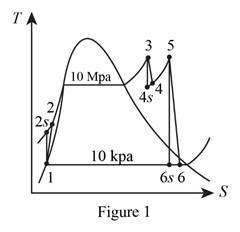
Consider a steam power plant that operates on a reheat Rankine cycle. Steam enters the high-pressure turbine at 10 MPa and 500°C and the low-pressure turbine at 1 MPa and 500°C. Steam leaves the condenser as a saturated liquid at a pressure of 10 kPa. The isentropic efficiency of the turbine is 80 percent, and that of the pump is 95 percent. Determine the exergy destruction associated with the heat addition process and the expansion process. Assume a source temperature of 1600 K and a sink temperature of 285 K. Also, determine the exergy of the steam at the boiler exit. Take P0 = 100 kPa.
The exergy destruction associated with the heat addition, the expansion process, and the exergy of the steam at the boiler exit.
Answer to Problem 62P
The exergy destruction during the heating process is
The exergy destruction during the expansion process is
The exergy of the steam at the boiler exit is
Explanation of Solution
Draw the

Here, water is the working fluid.
Write the formula for work done by the pump during process 1-2 with the consideration of isentropic efficiency
Here, the specific volume is
Write the formula for enthalpy
Before reheating,
At state
The isentropic efficiency is expressed as follows.
After reheating,
At state 5:
The reheating occurs at constant pressure. Hence, the pressure at state 4 and state 5 are equal.
At state
The steam is expanded to the pressure of
The quality of water at the exit of the L.P turbine (state 6) is expressed as follows (actual).
The enthalpy at state 6 is expressed as follows.
Here, the enthalpy is
The isentropic efficiency is expressed as follows.
Here, the subscript
Write the formula for heat input
Write the formula for the exergy destruction for the combined heat addition and pumping process 1-5.
Here, the entropy
Write the formula for the exergy destruction for pumping process 1-2.
Here, the work input of pump at actual process 1-2 is
Write the formula for exergy destruction for heat addition processes 2-3, 4-5.
Write the formula for the exergy destruction for the expansion process 3-4, 5-6.
Write the formula for exergy of the steam at boiler exit
Here, the enthalpy is
Neglect the kinetic energy
At state 1:
The water exits the condenser as a saturated liquid at the pressure of
Refer Table A-5, “Saturated water-Pressure table”.
The enthalpy
At state 3: (H.P. Turbine inlet)
The steam enters the as superheated vapor.
Refer Table A-6, “Superheated water”.
The enthalpy
At state
From Figure 1.
Refer Table A-6, “Superheated water”.
The enthalpy
At state 5: (L.P. Turbine inlet)
The steam is reheated to superheated at the pressure of
Refer Table A-6, “Superheated water”.
The enthalpy
At state
From Figure 1.
Refer Table A-5, “Saturated water-Pressure table”.
Obtain the following properties corresponding to the pressure of
Here, the sink temperature is equal to the surrounding temperature.
The surrounding pressure
Refer Table A-4, “Saturated water-Temperature table”.
The enthalpy
Conclusion:
Substitute
Substitute
Substitute
Substitute
Substitute
Equation (V).
Substitute
Refer Table A-5, “Saturated water-Pressure table”.
Obtain the vapor enthalpy
The calculated enthalpy at state 6 is greater than the vapor enthalpy at this state. Hence, the steam is at superheated state.
Substitute
Consider the process 1 to 5 (combined heat addition and boiler).
Here,
Substitute 285 K for
Substitute
Substitute
Thus, the exergy destruction during the heating process is
Consider the process 3-4 and 5-6 (H.P. turbine expansion and L.P. turbine expansion).
Here,
Substitute 285 K for
Thus, the exergy destruction during the expansion process is
Substitute
Thus, the exergy of the steam at the boiler exit is
Want to see more full solutions like this?
Chapter 10 Solutions
EBK THERMODYNAMICS: AN ENGINEERING APPR
- Note: Please provide a clear, step-by-step simplified handwritten working out (no explanations!), ensuring it is done without any AI involvement. I require an expert-level answer, and I will assess and rate based on the quality and accuracy of your work and refer to the provided image for more clarity. Make sure to double-check everything for correctness before submitting thanks!. Question: (In the image as provided)arrow_forwardNote: Please provide a clear, step-by-step simplified handwritten working out (no explanations!), ensuring it is done without any AI involvement. I require an expert-level answer, and I will assess and rate based on the quality and accuracy of your work and refer to the provided image for more clarity. Make sure to double-check everything for correctness before submitting thanks!. Question: The rectangular gate shown below is 3 m wide. Compute the force P needed to hold the gate in the position shown.arrow_forwardNote: Please provide a clear, step-by-step simplified handwritten working out (no explanations!), ensuring it is done without any AI involvement. I require an expert-level answer, and I will assess and rate based on the quality and accuracy of your work and refer to the provided image for more clarity. Make sure to double-check everything for correctness before submitting thanks!. Question1: If the following container is 0.6m high, 1.2m wide and half full with water, determine the pressure acting at points A, B, and C if ax=2.6ms^-2.arrow_forward
- Please read the imagearrow_forwardChapter 12 - Lecture Notes.pptx: (MAE 272-01) (SP25) DY... Scoresarrow_forwardConsider a large 6-cm-thick stainless steel plate (k = 15.1 W/m-K) in which heat is generated uniformly at a rate of 5 × 105 W/m³. Both sides of the plate are exposed to an environment at 30°C with a heat transfer coefficient of 60 W/m²K. Determine the value of the highest and lowest temperature. The highest temperature is The lowest temperature is °C. °C.arrow_forwardSketch and explain a PV Diagram and a Temperature Entropy Diagram for a 4 stroke diesel engine please, please explain into detail the difference bewteen the two and referance the a diagram. Please include a sketch or an image of each diagramarrow_forwardDraw left view of the first orthographic projectionarrow_forwardSketch and Describe a timing diagram for a 2 stroke diesel engine emphasis on the 2 stroke as my last answer explained 4 stroke please include a diagram or sketch.arrow_forwardA 4 ft 200 Ib 1000 Ib.ft C 2 ft 350 Ib - за в 2.5 ft 150 Ib 250 Ib 375 300 Ib Replace the force system acting on the frame. shown in the figure by a resultant force (magnitude and direction), and specify where its line of action intersects member (AB), measured from point (A).arrow_forwardA continuous flow calorimeter was used to obtain the calorific value of a sample of fuel and the following data collected: Mass of fuel: 2.25 kgInlet water temperature: 11 ° COutlet water temperature 60 ° CQuantity of water: 360 Liters Calorimeter efficiency: 85%Calculate the calorific value of the sample ( kJ / kg ). ive submitted this question twice and have gotten two way different answers. looking for some help thanksarrow_forward15 kg of steel ball bearings at 100 ° C is immersed in 25 kg of water at 20 ° C . Assuming no loss of heat to or from the container, calculate the final temperature of the water after equilibrium has been attained.Specific heat of steel: 0.4857 kJ / kg / ° KSpecific heat of water: 4.187 kJ / kg / ° Karrow_forwardarrow_back_iosSEE MORE QUESTIONSarrow_forward_ios
 Elements Of ElectromagneticsMechanical EngineeringISBN:9780190698614Author:Sadiku, Matthew N. O.Publisher:Oxford University Press
Elements Of ElectromagneticsMechanical EngineeringISBN:9780190698614Author:Sadiku, Matthew N. O.Publisher:Oxford University Press Mechanics of Materials (10th Edition)Mechanical EngineeringISBN:9780134319650Author:Russell C. HibbelerPublisher:PEARSON
Mechanics of Materials (10th Edition)Mechanical EngineeringISBN:9780134319650Author:Russell C. HibbelerPublisher:PEARSON Thermodynamics: An Engineering ApproachMechanical EngineeringISBN:9781259822674Author:Yunus A. Cengel Dr., Michael A. BolesPublisher:McGraw-Hill Education
Thermodynamics: An Engineering ApproachMechanical EngineeringISBN:9781259822674Author:Yunus A. Cengel Dr., Michael A. BolesPublisher:McGraw-Hill Education Control Systems EngineeringMechanical EngineeringISBN:9781118170519Author:Norman S. NisePublisher:WILEY
Control Systems EngineeringMechanical EngineeringISBN:9781118170519Author:Norman S. NisePublisher:WILEY Mechanics of Materials (MindTap Course List)Mechanical EngineeringISBN:9781337093347Author:Barry J. Goodno, James M. GerePublisher:Cengage Learning
Mechanics of Materials (MindTap Course List)Mechanical EngineeringISBN:9781337093347Author:Barry J. Goodno, James M. GerePublisher:Cengage Learning Engineering Mechanics: StaticsMechanical EngineeringISBN:9781118807330Author:James L. Meriam, L. G. Kraige, J. N. BoltonPublisher:WILEY
Engineering Mechanics: StaticsMechanical EngineeringISBN:9781118807330Author:James L. Meriam, L. G. Kraige, J. N. BoltonPublisher:WILEY





